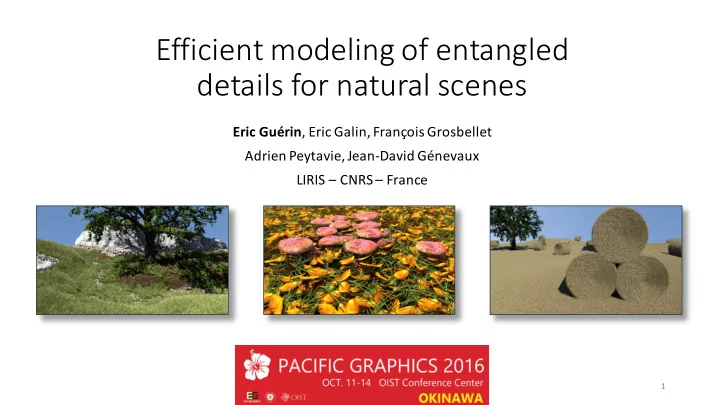

Efficient modeling of entangled details for natural scenes Eric Guérin , Eric Galin, François Grosbellet Adrien Peytavie, Jean-David Génevaux LIRIS – CNRS – France 1
Introduction PG Introduction Method Results Conclusion 2 2016
Context/problem • Natural scenes Numerous details • Entangled • Different kinds • ⇒ Tedious authoring Twigs Grass tufts Stones PG Introduction Method Results Conclusion 3 2016
Related work Simulations Interactive editing Procedural [Alsweis 2006] [Grosbellet 2016] [Hsu 2010] [Desbenoit 2006] [Peytavie 2009] [Emilien 2015] + Efficient + Control + Realistic – Specific – Specific – Limited user control – Memory – Interpenetrations – Does not scale PG Introduction Method Results Conclusion 4 2016
Our approach • Key observation: if not regular, repetitions are not visible + Realistic • Split the process into + Efficient two steps + Not object-specific 1. Pre-compute collisions + Light in memory in a very dense tile + Scalable 2. Fast Instantiation + Controllable • Multiple control types PG Introduction Method Results Conclusion 5 2016
The method PG Introduction Method Results Conclusion 6 2016
Pipeline in 2 steps Density fields Input objects Ghost Tile 1. Ghost Tile 2. Instantiation Generation Candidates Collision graph PG Introduction Method Results Conclusion 7 2016
The method Step 1 – Ghost tile construction PG Introduction Method Results Conclusion 8 2016
Ghost tile Objects O O 1 O 2 Ghost Tile T 1 O 1 O 1 2 Frames F 1 1 2 F F F 1 2 2 2 2 O ⊕ − x O 2 2 j j Candidates O = F (O ) i i i 1 O ⊕ − y 1 Collision graph G PG Introduction Method Results Conclusion 9 2016
Ghost tile construction Algorithm 1. Pick a random frame in the tile 2. Compute intersections inside the same tile in the neighbor tiles 3. If intersection, add two reciprocal arcs in the graph ⇒ Repeat (and use a spatial acceleration) PG Introduction Method Results Conclusion 10 2016
Collision detection • Volume approximated by spheres • Automatic or manual according to the context Distance between unions of spheres is easy Stone Leaf PG Introduction Method Results Conclusion 11 2016
The method Step 2 : Instantiation PG Introduction Method Results Conclusion 12 2016
Density description Stones density function f j Density functions f i : R 3 → R Twigs density function f i PG Introduction Method Results Conclusion 13 2016
Culling step • Remove candidates whose density vanishes at anchor point(s) a k i k f > 0 f ( a + t ) > 0 i f = 0 a k j k f ( a ) = 0 j Ghost Tile T T ⊕ x PG Introduction Method Results Conclusion 14 2016
Instantiation step • Select the highest priority candidate (green) • Discard colliding candidates (orange) 2 O 1 1 O 1 4 O 4 1 O ⊕ − x 3 1 O 1 T ⊕ − x Ghost Tile T T ⊕ x PG Introduction Method Results Conclusion 15 2016
Priorities Distance to the Distance to the Random Altitude boundary boundary + partial filling 4.3k instances 4.5k instances 4.5k instances 3.8k instances PG Introduction Method Results Conclusion 16 2016
Results PG Introduction Method Results Conclusion 17 2016
Volumetric objects Method that accounts for volumetric objects PG Introduction Method Results Conclusion 18 2016
Control over density Density functions to control the relative density of each object type 23k instances 19k instances 18k instances PG Introduction Method Results Conclusion 19 2016
Complex scenes - Borie 63k flat stones Instantiation time 17s PG Introduction Method Results Conclusion 20 2016
Complex scenes - Field 4.3M straw instances Instantiation time 54.6s PG Introduction Method Results Conclusion 21 2016
Complex scenes - Meadow Interactive authoring Standard stroke 1k instances in 1.5s PG Introduction Method Results Conclusion 22 2016
Conclusion PG Introduction Method Results Conclusion 23 2016
Conclusion Limitations • No structure • No animation • General framework to model entangled • details Two steps • 1. Offline pre-computation 2. Instantiation Efficient • Handle interpenetrations • Several user controls • PG Introduction Method Results Conclusion 24 2016
Thank you for your attention! See video and more on: http://liris.cnrs.fr/eric.guerin/efficient-modeling-of-entangled-details-for-natural-scenes/ PG 25 2016
Recommend
More recommend